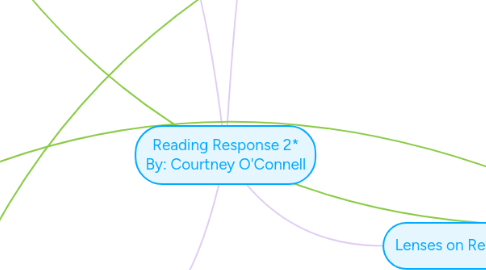Reading Response 2* By: Courtney O'Connell
by Courtney O'Connell


1. Rosenblatt, 2013
1.1. "Human activities and relationships are seen as transactions in which the individual and social elements fuse with cultural and natural elements" (Rosenblatt, 2013) The idea that a person brings their culture into their reading.
1.2. "We make sense of a new situation or translation and make new meanings by applying, reorganizing, revising or extending public and private elements." (Rosenblatt, 2013)
1.2.1. Like the other articles, Rosenblatt believes that our schemata is ever changing.
1.3. "The linguistic-experiential reservoir reflects the reader's cultural, social and personal history."( Rosenblatt, 2013)
1.4. Rosenblatt believes that although writing may seem like a free thinking activitey, the ideas are not coming out of thin air. they are coming from your background knowledge and life experiences.
1.5. It is important to set a purpose when teaching reading and writing. Linking purpose will allow students to activiely engage in the task and bring their own knowledge to better complete the task.
2. Luke & Freebody, 1997
2.1. "Redefinition of reading toward the view that it is about engaging with, transforming and critiquing a particular culture of subculture's way of seeing the owrld its way of valuing, weighing and understanding the world" (Luke, 1997)
2.2. "Our point here is that the teaching of reading is in fact the teaching of cultural ways of looking, describing and explaining (Gee, 1996)" (Lukey, 1997)
2.2.1. Different cultures introduce topics at different times in life. People who speak different languages can comprehend many subjects.
2.3. "...a strong correlation between the level of reading they detirmined and peoplse exposure to various tasks..." (Luke, 1997)
2.3.1. Peoples experiences have a dirrect affect on their ability to read and comprehend.
3. Lenses on Reading
3.1. John Dewey was a American Constructivist. Dewey's philosophy of education became known as inquiry learning and problem-based learning. Students are to take responsibility for their own learning.
3.2. "Everyone's schemas are individualized" "Schema Theory articulates three processes through which knowledge structures change: accreditation, tuning and restrcution" (Tracey, 2006)
3.2.1. "Schema Theory students actively construct and revies their schemas as they read and learn. Furthermore as they read and learn students use their exisiting schemas for language and content to assist with new reading and learning experience"

